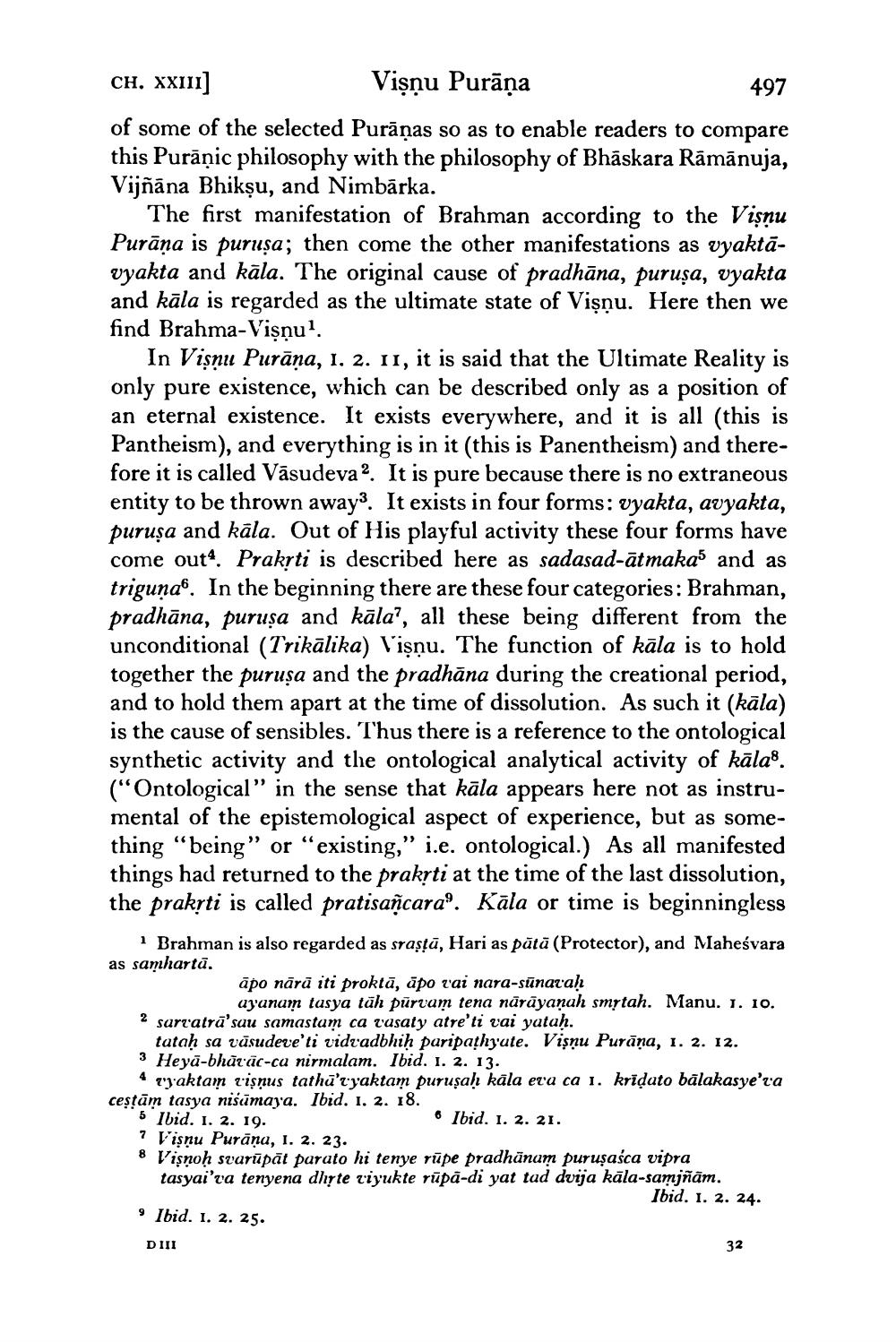________________
CH. XX11] Vişņu Purāņa
497 of some of the selected Purāṇas so as to enable readers to compare this Purāņic philosophy with the philosophy of Bhāskara Rāmānuja, Vijñāna Bhikṣu, and Nimbārka.
The first manifestation of Brahman according to the Vişnu Purāņa is puruşa; then come the other manifestations as vyaktāvyakta and kāla. The original cause of pradhāna, purușa, vyakta and kāla is regarded as the ultimate state of Vişnu. Here then we find Brahma-Vişnu?
In Vişnu Purāņa, 1. 2. 11, it is said that the Ultimate Reality is only pure existence, which can be described only as a position of an eternal existence. It exists everywhere, and it is all (this is Pantheism), and everything is in it (this is Panentheism) and therefore it is called Vāsudeva? It is pure because there is no extraneous entity to be thrown away? It exists in four forms: vyakta, avyakta, purusa and kāla. Out of His playful activity these four forms have come out4. Prakrti is described here as sadasad-ātmakas and as triguna6. In the beginning there are these four categories: Brahman, pradhāna, purusa and kāla?, all these being different from the unconditional (Trikālika) Vişnu. The function of kāla is to hold together the puruşa and the pradhāna during the creational period, and to hold them apart at the time of dissolution. As such it (kāla) is the cause of sensibles. Thus there is a reference to the ontological synthetic activity and the ontological analytical activity of kāla. (“Ontological” in the sense that kāla appears here not as instrumental of the epistemological aspect of experience, but as something “being” or “existing,” i.e. ontological.) As all manifested things had returned to the prakrti at the time of the last dissolution, the prakrti is called pratisañcara". Kāla or time is beginningless
āpo nārā tasya täh pūrvamereti vai yatuknu Purāna, 1.
1 Brahman is also regarded as sraştā, Hari as pātā (Protector), and Maheśvara as samhartā.
āpo nārā iti proktā, āpo vai nara-sūnarah
ayanam tasya tāh pūrvam tena nārāyanah smrtah. Manu. 1. 10. 2 sarvatrā sau samastam ca vasaty atre'ti vai yatah.
tataḥ sa vasudeve'ti vidradbhiḥ paripathyute. Vişnu Purāņa, I. 2. 12. 3 Heya-bhātāc-ca nirmalam. Ibid. 1. 2. 13.
Tyaktain tişņus tathā'z yaktam puruşah kāla era ca 1. kridato bālakasye'ra cestām tasya nišāmaya. Ibid. 1. 2. 18. 5 Ibid. 1. 2. 19.
6 Ibid. 1. 2. 21. 7 Visnu Purāņa, I. 2. 23. 8 Vişnoh svarūpāt parato hi tenye rūpe pradhānam puruşaśca vipra
tasyai'ra tenyena dhrte riyukte rūpā-di yat tad dvija kāla-samjñām.
se rūpe pradhānau dvija kāla-Sibid. 1. 2. 24.
9 Ibid. 1. 2. 25.
DIII
32




